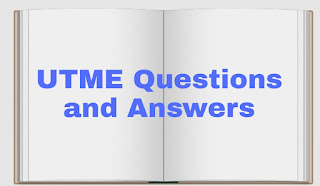UTME Physics questions and answers
Here are 20 UTME (Unified Tertiary Matriculation Examination) physics questions along with multiple-choice options and the correct answers for each:
Which of the following statements about inertia is correct?
A) Inertia depends on an object's mass.
B) Inertia depends on an object's weight.
C) Inertia depends on an object's volume.
D) Inertia depends on an object's velocity.
Correct answer: A) Inertia depends on an object's mass.
The rate at which work is done is called:
A) Energy
B) Power
C) Force
D) Momentum
Correct answer: B) Power
Which of the following is NOT a vector quantity?
A) Velocity
B) Acceleration
C) Time
D) Force
Correct answer: C) Time
Which of the following is a renewable source of energy?
A) Natural gas
B) Coal
C) Nuclear energy
D) Solar power
Correct answer: D) Solar power
A convex lens can produce which of the following types of images?
A) Real, inverted, and diminished
B) Virtual, upright, and enlarged
C) Real, upright, and enlarged
D) Virtual, inverted, and diminished
Correct answer: B) Virtual, upright, and enlarged
Which of the following phenomena explains why a pencil appears broken when placed in a glass of water?
A) Reflection
B) Diffraction
C) Dispersion
D) Refraction
Correct answer: D) Refraction
The electrical resistance of a conductor depends on its:
A) Length
B) Cross-sectional area
C) Material
D) All of the above
Correct answer: D) All of the above
The pitch of a sound is primarily determined by its:
A) Amplitude
B) Frequency
C) Velocity
D) Wavelength
Correct answer: B) Frequency
The unit of electric current is:
A) Ohm
B) Watt
C) Ampere
D) Volt
Correct answer: C) Ampere
According to Ohm's law, the current flowing through a conductor is directly proportional to:
A) Voltage across the conductor
B) Resistance of the conductor
C) Power dissipated in the conductor
D) Temperature of the conductor
Correct answer: A) Voltage across the conductor
Which of the following is an example of a contact force?
A) Gravitational force
B) Magnetic force
C) Frictional force
D) Electrostatic force
Correct answer: C) Frictional force
An object is moving with a constant velocity. Which of the following statements is true?
A) The object has no acceleration.
B) The object is at rest.
C) The object is slowing down.
D) The object is changing direction.
Correct answer: A) The object has no acceleration.
Which of the following statements is true about nuclear fission?
A) It releases energy by combining small atomic nuclei.
B) It is the process that powers the Sun.
C) It involves the splitting of large atomic nuclei.
D) It occurs naturally in radioactive elements.
Correct answer: C) It involves the splitting of large atomic nuclei.
Which of the following is an example of projectile motion?
A) A stone falling from a cliff.
B) A car moving on a straight road.
C) A pendulum swinging back and forth.
D) A ball thrown into the air.
Correct answer: D) A ball thrown into the air.
According to Newton's third law of motion, for every action, there is:
A) An equal and opposite reaction.
B) An equal reaction only.
C) A larger reaction.
D) No reaction.
Correct answer: A) An equal and opposite reaction.
Which of the following electromagnetic waves has the shortest wavelength?
A) Radio waves
B) Microwaves
C) X-rays
D) Gamma rays
Correct answer: D) Gamma rays
The SI unit of pressure is:
A) Pascal
B) Joule
C) Newton
D) Watt
Correct answer: A) Pascal
Which of the following best describes the motion of a body in uniform circular motion?
A) Constant speed and changing velocity
B) Changing speed and constant velocity
C) Constant speed and constant velocity
D) Changing speed and changing velocity
Correct answer: A) Constant speed and changing velocity
The phenomenon of total internal reflection occurs when light travels from:
A) A denser medium to a rarer medium at an angle greater than the critical angle.
B) A rarer medium to a denser medium at an angle less than the critical angle.
C) A denser medium to a rarer medium at an angle less than the critical angle.
D) A rarer medium to a denser medium at an angle greater than the critical angle.
Correct answer: A) A denser medium to a rarer medium at an angle greater than the critical angle.
The process of converting a solid directly into a gas without passing through the liquid state is called:
A) Melting
B) Boiling
C) Sublimation
D) Condensation
Correct answer: C) Sublimation
These questions cover a range of topics in physics and should provide you with good practice for the UTME.

Post a Comment